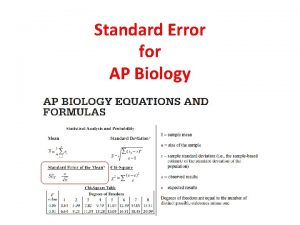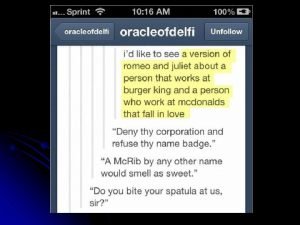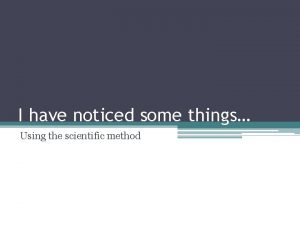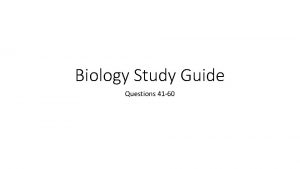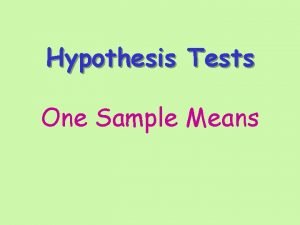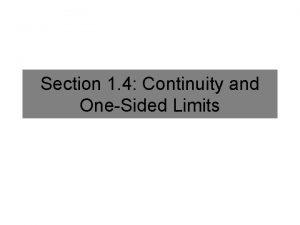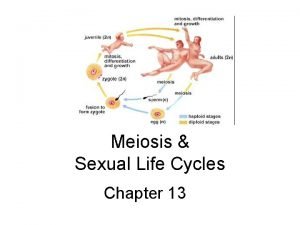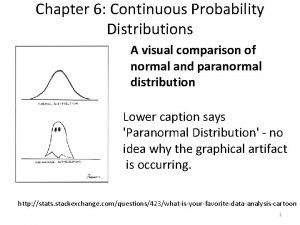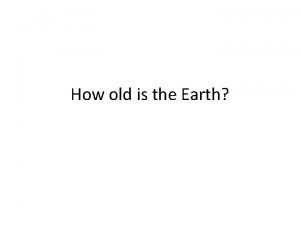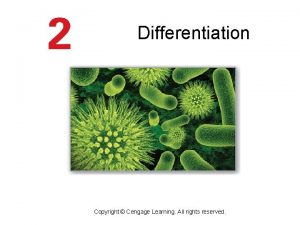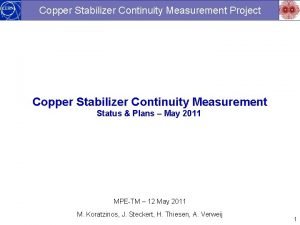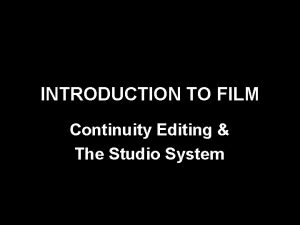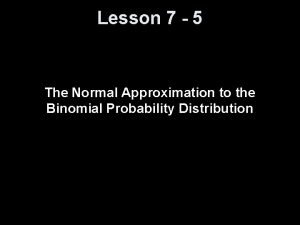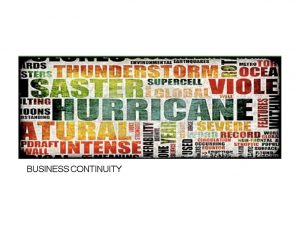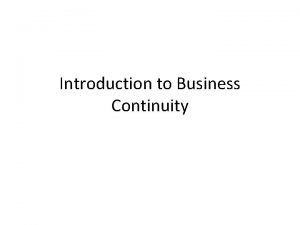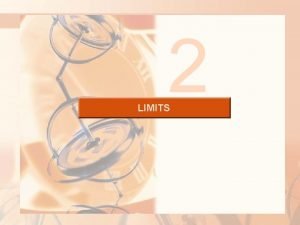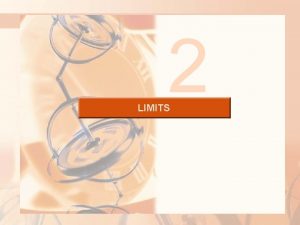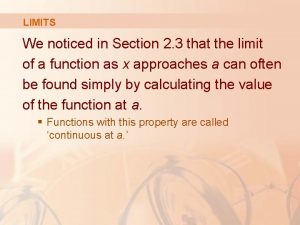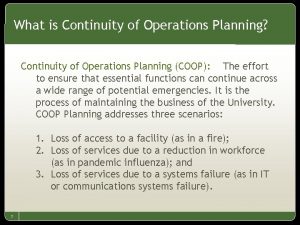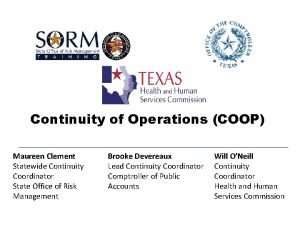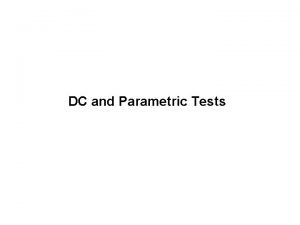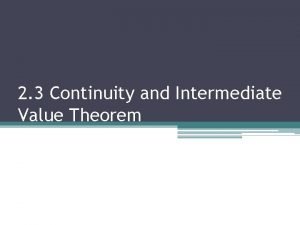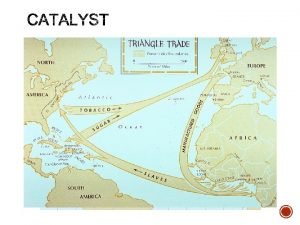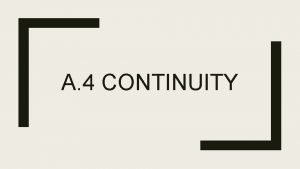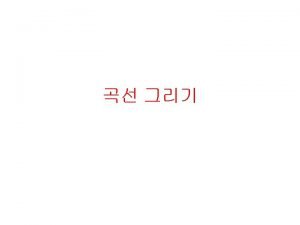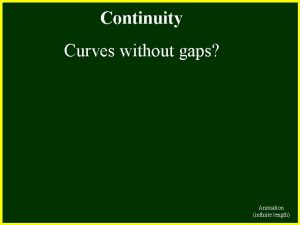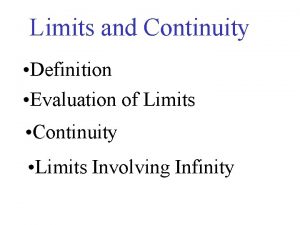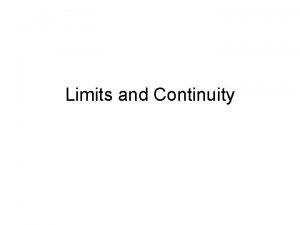CONTINUITY CONTINUITY v We noticed in Section 1


























- Slides: 26

CONTINUITY

CONTINUITY v. We noticed in Section 1. 4 that the limit of a function as x approaches a can often be found simply by calculating the value of the function at a. n n Functions with this property are called ‘‘continuous at a. ’’ We will See that the mathematical definition of continuity corresponds closely with the meaning of the word continuity in everyday language. 1. 5 P 2

Definition 1 A function f is continuous at a number a if: v. Notice that Definition 1 implicitly requires three things if f is continuous at a: n n f(a) is defined—that is, a is in the domain of f exists. n 1. 5 P 3

CONTINUITY v. The definition states that f is continuous at a if f(x) approaches f(a) as x approaches a. n n Thus, a continuous function f has the property that a small change in x produces only a small change in f(x). In fact, the change in f(x) can be kept as small as we please by keeping the change in x sufficiently small. 1. 5 P 4

CONTINUITY v. If f is defined near a—that is, f is defined on an open interval containing a, except perhaps at a— we say that f is discontinuous at a (or f has a discontinuity at a) if f is not continuous at a. v. Physical phenomena are usually continuous. n For instance, the displacement or velocity of a vehicle varies continuously with time, as does a person’s height. 1. 5 P 5

CONTINUITY v. However, discontinuities do occur in such situations as electric currents. n See Example 6 in Section 1. 3, where the Heaviside function is discontinuous at 0 because does not exist. v. Geometrically, you can think of a function that is continuous at every number in an interval as a function whose graph has no break in it. n The graph can be drawn without removing your pen from the paper. 1. 5 P 6

Example 1 v. Figure 2 shows the graph of a function f. At which numbers is f discontinuous? Why? 1. 5 P 7

Example 1 SOLUTION v. It looks as if there is a discontinuity when a = 1 because the graph has a break there. n The official reason that f is discontinuous at 1 is that f(1) is not defined. 1. 5 P 8

Example 1 SOLUTION v. The graph also has a break when a = 3. However, the reason for the discontinuity is different. n n Here, f(3) is defined, but does not exist (because the left and right limits are different). So, f is discontinuous at 3. 1. 5 P 9

Example 1 SOLUTION v. What about a = 5? n n n Here, f(5) is defined and exists (because the left and right limits are the same). However, So, f is discontinuous at 5. 1. 5 P 10

CONTINUITY v. Now, let’s see how to detect discontinuities when a function is defined by a formula. 1. 5 P 11

Example 2 v. Where are each of the following functions discontinuous? (a) (b) (c) (d) 1. 5 P 12

Example 2(a) SOLUTION v. Notice that f(2) is not defined. So, f is discontinuous at 2. n Later, we’ll see why f is continuous at all other numbers. 1. 5 P 13

Example 2(b) SOLUTION (b)Here, f(0) = 1 is defined. does not exist. n See Example 8 in Section 1. 3. v. So, f is discontinuous at 0. 1. 5 P 14

Example 2(c) SOLUTION v. Here, f(2) = 1 is defined and exists. But So, f is not continuous at 2. 1. 5 P 15

Example 2(d) SOLUTION v. The greatest integer function has discontinuities at all the integers. This is because does not exist if n is an integer. n See Example 8 in Section 1. 4. 1. 5 P 16

CONTINUITY v. Figure 3 shows the graphs of the functions in Example 2. n In each case, the graph can’t be drawn without lifting the pen from the paper—because a hole or break or jump occurs in the graph. 1. 5 P 17

CONTINUITY v. The kind of discontinuity illustrated in parts (a) and (c) is called removable. n n We could remove the discontinuity by redefining f at just the single number 2. The function is continuous. 1. 5 P 18

CONTINUITY v. The discontinuity in part (b) is called an infinite discontinuity. 1. 5 P 19

CONTINUITY v. The discontinuities in part (d) are called jump discontinuities. n The function ‘‘jumps’’ from one value to another. 1. 5 P 20

Definition 2 A function f is continuous from the right at a number a if and f is continuous from the left at a if 1. 5 P 21

Example 3 v. At each integer n, the function is continuous from the right but discontinuous from the left because but 1. 5 P 22

Definition 3 A function f is continuous on an interval if it is continuous at every number in the interval. (If f is defined only on one side of an endpoint of the interval, we understand ‘‘continuous at the endpoint’’ to mean ‘‘continuous from the right’ or ‘continuous from the left. ’’) 1. 5 P 23

Example 4 v. Show that the function is continuous on the interval [– 1, 1]. v. SOLUTION n If – 1 < a < 1, then using the Limit Laws, we have: 1. 5 P 24

Example 4 SOLUTION n n Thus, by Definition 1, f is continuous at a if – 1 < a < 1. Similar calculations show that So, f is continuous from the right at – 1 and continuous from the left at 1. Therefore, according to Definition 3, f is continuous on [– 1, 1]. 1. 5 P 25

Example 4 SOLUTION v. The graph of f is sketched in the Figure 4. n It is the lower half of the circle 1. 5 P 26
 Absolute continuity implies uniform continuity
Absolute continuity implies uniform continuity Standard error of the mean ap biology
Standard error of the mean ap biology Vocab unit 12 level d
Vocab unit 12 level d Things i have noticed
Things i have noticed What inclusions have you noticed
What inclusions have you noticed Darwin noticed that many organisms seemed well suited to
Darwin noticed that many organisms seemed well suited to A whale watching company noticed that many customers
A whale watching company noticed that many customers Revolved sectional view
Revolved sectional view Chapter 10 meiosis 1 and meiosis 2
Chapter 10 meiosis 1 and meiosis 2 Revolved section meaning
Revolved section meaning Section view
Section view Section 2 describing energy (continued)
Section 2 describing energy (continued) Unilateral continuity
Unilateral continuity How does mitosis maintain genetic continuity
How does mitosis maintain genetic continuity Continuity and change essay
Continuity and change essay Unique forms of continuity in space
Unique forms of continuity in space Continuity correction
Continuity correction Fusion business continuity
Fusion business continuity Emc business continuity
Emc business continuity Lateral continuity
Lateral continuity Does continuity imply differentiability
Does continuity imply differentiability Rapat arus pergeseran
Rapat arus pergeseran Houston business continuity planning
Houston business continuity planning Continuity
Continuity Continuity editing is a system for
Continuity editing is a system for Jive voice
Jive voice Continuity correction
Continuity correction

